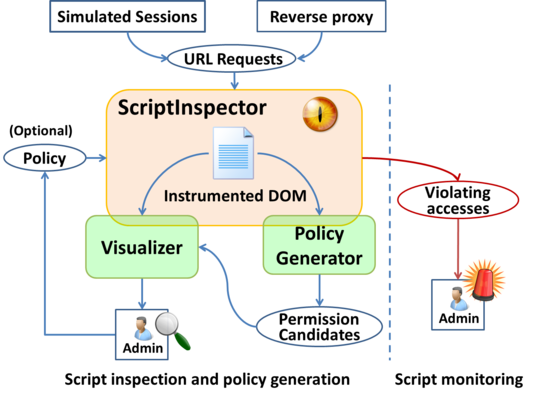Archive for the 'Security' Category
Monday, August 31st, 2015
Atlas Obscura has an article about Karsten Nohl (PhD 2009):
Exit Interview: I’m A Crypto-Specialist Working To Secure the Internet For A Billion People, Jeremy Berke, 28 July 2015.
One of the things we’re building is a PayPal competitor–with a modest target of having a few hundred million customers. Everything in India is always on a massive scale. If you could get rid of PayPal passwords, and instead just have a fingerprint–if you could pay for goods at a store with just your fingerprint, that would simplify people’s lives a lot. It would also have the secondary effect of saving some of the security problems, like phishing, that we currently encounter. And this government database is a huge enabler.
If we already have a mandate to collect everybody’s fingerprints, why not use it in the customer’s benefit? The privacy risk is always there. That’s the law and I can’t argue with that. But if the law is already creating this risk, why not create opportunity in the same step?
Posted in Alumni, News, Privacy, Research, Security, USB | Comments Off
Friday, June 5th, 2015
I went to a very interesting meeting at Darmstadt: CROSSING – Where Quantum Physics, Cryptography, System Security and Software Engineering meet. Lots more diversity than my typical computer security meeting, including a lively debate on quantum physics and superfluid vacuum theory between Nicolas Grisin (founder of ID Quantique and Ross Anderson. Interesting to learn that China is building a huge quantum key distribution network.
I gave a talk on Multi-Party Computation for the Masses:
CROSSING is a 12-year project funded by the German Science Foundation (with reviews every 4 years). Gives some context to US funding agencies that talk about long-range visionary projects with 5-year timelines.
Posted in Conferences, Cryptography, Research, Secure Computation, Security, Talks | Comments Off
Sunday, May 24th, 2015
Several SRGers were at IEEE Symposium on Security and Privacy (“Oakland” in San Jose).
Yuchen Zhou presented his work on Understanding and Monitoring Embedded Web Scripts. Yuchen graduated with his PhD the day before the conference, and will be joining Palo Alto Networks.
Samee Zahur is a co-author (along with Benjamin Kreuter, who is an “in-progress UVa PhD student” diverted by Google, and several researchers from Microsoft Research) on the paper, Geppetto: Versatile Verifiable Computation, which was presented by Bryan Parno.
Samee also presented a poster on Obliv-C.
Weilin Xu presented a poster on Automatically Evading Classifiers
It was also great to see SRG alums Yan Huang (who is not at Indiana University, and was a co-author on the paper about ObliVM), Jon McCune (who is now working on trusted computing at Google) and Adrienne Felt (who was the keynote speaker for the W2SP workshop, and gave a very interesting talk about user-facing security design and experiments in Google Chrome; Adrienne’s first paper was in W2SP 2008 when she was an undergraduate at UVa).
Posted in Alumni, Conferences, Papers, Program Analysis, Research, Secure Computation, Security, Talks, Web Security | Comments Off
Thursday, March 26th, 2015
Modern web applications make frequent use of third-party scripts, often in ways that allow scripts loaded from external servers to make unrestricted changes to the embedding page and access critical resources including private user information. Our paper describing tools to assist site administrators in understanding, monitoring, and restricting the behavior of third-party scripts embedded in their site, and what we’ve learned by using them, is now available: Yuchen Zhou and David Evans, Understanding and Monitoring Embedded Web Scripts, IEEE Symposium on Security and Privacy 2015.
Yuchen will present the paper at the Oakland conference (in San Jose) this May.

Project Site: ScriptInspector.org
Posted in Conferences, Papers, Privacy, Program Analysis, Research, Security, Web Security | Comments Off
Wednesday, March 25th, 2015
This (perhaps somewhat oversensationalized) article in Slate draws from Nate Paul’s research on medical device security: If you Die after Someone Hacks Your Glucose Monitor Who Does the Autopsy? (Slate, 13 March 2015).
According to researchers at the Oak Ridge National Laboratory, in 2003 and 2009 respectively, the “Slammer” and “Conficker” worms had each successfully infected networked hospital systems responsible for monitoring heart patients. Since the days of Slammer and Conficker, malware has since become even more sophisticated, and a Trojan with a specifically engineered piece of malicious code, could cause harm to numerous patients around the world simultaneously.
While a small community of researchers, and even some government regulators, such as the FDA and FTC, have begun to pose important questions about the privacy and security implications of incorporating computer technology into biological systems, so far law enforcement and criminal justice authorities have been mostly absent from any substantive conversations.
Posted in Medical Devices, Privacy, Research, Security | Comments Off
Tuesday, March 17th, 2015
Congratulations to Samee Zahur for winning the iDash Secure Genomics competition (Hamming Distance challenge task), sponsored by Human Longevity, Inc. A video of the event is available at http://www.humangenomeprivacy.org/.
Samee’s solution was built using Obliv-C, and the code will be posted soon.
Posted in Awards, Conferences, Contests, Privacy, Security | Comments Off
Monday, February 9th, 2015
UVAToday has an article about Yuchen Zhou’s work on analyzing web scripts: Giving Web Developers Tools to Protect Their Sites and Users, UVAToday, 5 February 2015.
Zhou also devised a tool that developers could use to constrain the activity of the hundreds of scripts they typically embed in a website. In the process of performing analytics or placing ads, these scripts gather user-generated information on a page and send it to their servers. There is no guaranteeing, however, that these servers are secure or that the companies offering these services are trustworthy. In other cases, scripts ostensibly offering a benign service like analytics could take over the page, replacing the site-owner’s ads with their own ads or stealing private user information from the page.
Rather than try to develop rules for every page on a site, Zhou’s tool generates a set of policies that can be applied to the site as a whole. It catalogs the elements of the site based on their content and their relationship to the structure of the page and specifies which elements can be accessed by specific scripts. “We’ve found that using a white list approach – specifying which elements a script can use rather than those it can’t – is more effective because it is easier to automatically identify public elements like an ad placeholder than sensitive information in the page,” Zhou said. The site owner can then review the policies and grant permissions accordingly.
Posted in Research, Security, Web Security | Comments Off
Thursday, January 15th, 2015
Group alumna Adrienne Felt is in the news for reporting that Gogo in-flight wifi service is generating fake SSL certificates.
From Gogo Inflight Wi-Fi Undermines Encryption, Slate FutureTense, 5 Jan 2015:
Wi-Fi on planes is unreliable and expensive. Even worse: Service from Gogo—one of the primary providers of in-flight Internet—has a lot of strange insecurities. Google engineer Adrienne Porter Felt realized during a flight on Friday that, for Google services and possibly others, Gogo was undermining encryption meant to keep pages secure.
Posted in Alumni, Security, Web Security | Comments Off
Tuesday, November 18th, 2014
Karsten Nohl’s research on USB security is covered in The Good News and Bad News About USB Security — Only half have an unpatchable flaw, but we don’t know which half, Wired and Slate Magazine, 12 Nov 2014:
Nohl’s BadUSB attack, which he revealed at the Black Hat security conference in August, takes advantage of the fact that a USB controller chip’s firmware can be reprogrammed. That means a thumb drive’s controller chip itself, rather than the Flash storage on that memory stick, can be infected with malware that invisibly spreads to computers, corrupts files stored on the drive, or quietly begins impersonating a USB keyboard to type commands on the victim’s machine.
…
Nohl says that means combatting BadUSB will require device-makers to clearly label the chips their products use. “You’d never get away with this in a laptop. People would go crazy if they bought a computer and it wasn’t the chip they saw in the review they read,” he says. “It’s just these USB devices that come as black boxes.”
For the technical details, see https://opensource.srlabs.de/projects/badusb.
Posted in Alumni, Research, Security, USB | Comments Off
Sunday, September 7th, 2014

Yan Huang, who completed his PhD in 2012 and then was a post-doc at the University of Maryland, is now an Assistant Professor at Indiana University. See his IU faculty page and personal blog. IU is the home of several well-known security researchers including
Jean Camp, Steven Myers and XioFeng Wang, as well as one of my favorite authors, Douglas Hofstadter.
Posted in Alumni, Research, Secure Computation, Security | Comments Off


